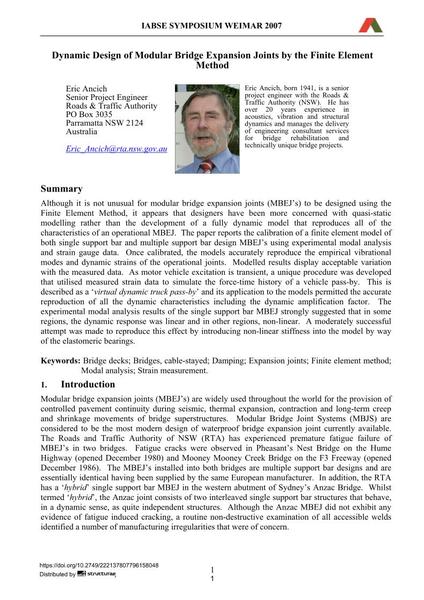Dynamic design of modular bridge expansion joints by the finite element method

|
|
|||||||||||
Bibliographic Details
| Author(s): |
Eric Ancich
|
||||
|---|---|---|---|---|---|
| Medium: | conference paper | ||||
| Language(s): | English | ||||
| Conference: | IABSE Symposium: Improving Infrastructure Worldwide, Weimar, Germany, 19-21 September 2007 | ||||
| Published in: | IABSE Symposium Weimar 2007 | ||||
|
|||||
| Page(s): | 304-305 | ||||
| Total no. of pages: | 9 | ||||
| Year: | 2007 | ||||
| DOI: | 10.2749/222137807796158048 | ||||
| Abstract: |
Although it is not unusual for modular bridge expansion joints (MBEJ’s) to be designed using the Finite Element Method, it appears that designers have been more concerned with quasi-static modelling rather than the development of a fully dynamic model that reproduces all of the characteristics of an operational MBEJ. The paper reports the calibration of a finite element model of both single support bar and multiple support bar design MBEJ’s using experimental modal analysis and strain gauge data. Once calibrated, the models accurately reproduce the empirical vibrational modes and dynamic strains of the operational joints. Modelled results display acceptable variation with the measured data. As motor vehicle excitation is transient, a unique procedure was developed that utilised measured strain data to simulate the force-time history of a vehicle pass-by. This is described as a ‘virtual dynamic truck pass-by’ and its application to the models permitted the accurate reproduction of all the dynamic characteristics including the dynamic amplification factor. The experimental modal analysis results of the single support bar MBEJ strongly suggested that in some regions, the dynamic response was linear and in other regions, non-linear. A moderately successful attempt was made to reproduce this effect by introducing non-linear stiffness into the model by way of the elastomeric bearings. |
||||
| Keywords: |
bridges finite element method (FEM) modal analysis bridge decks damping cable-stayed expansion joints strain measurement
|
||||
